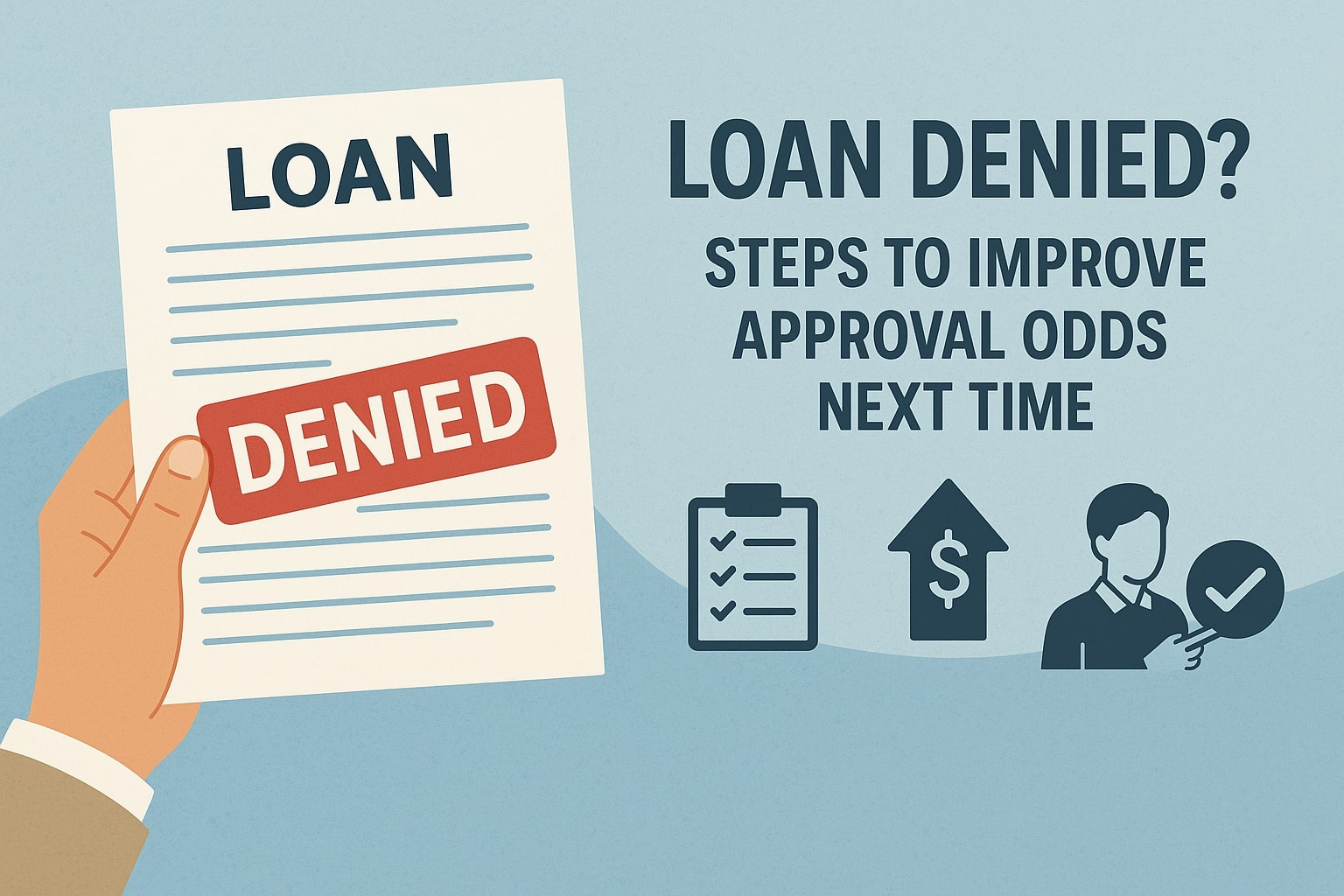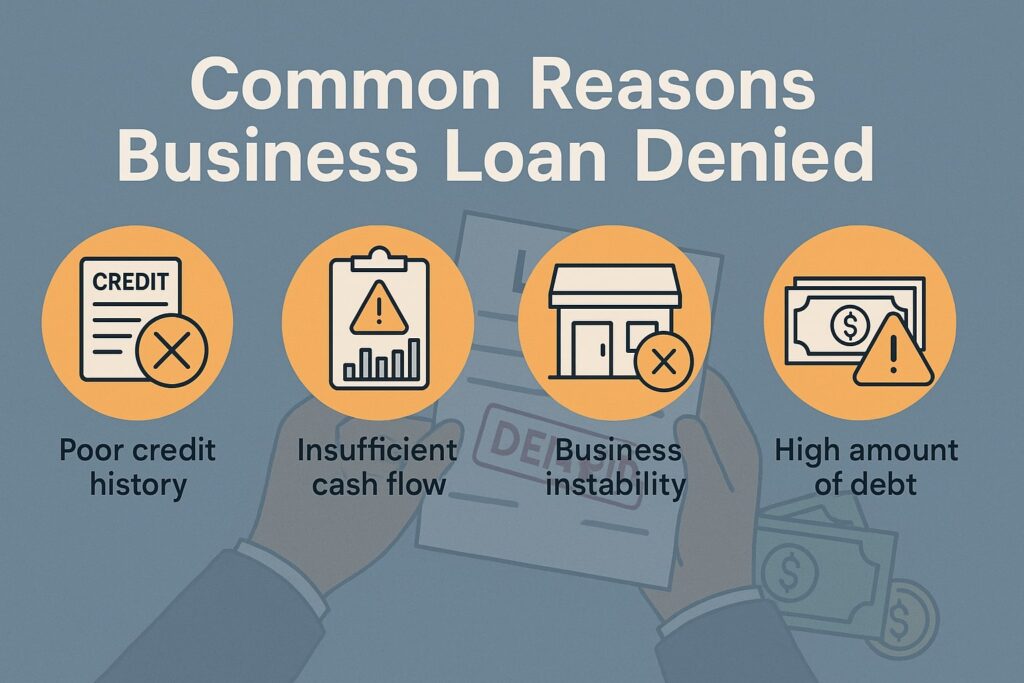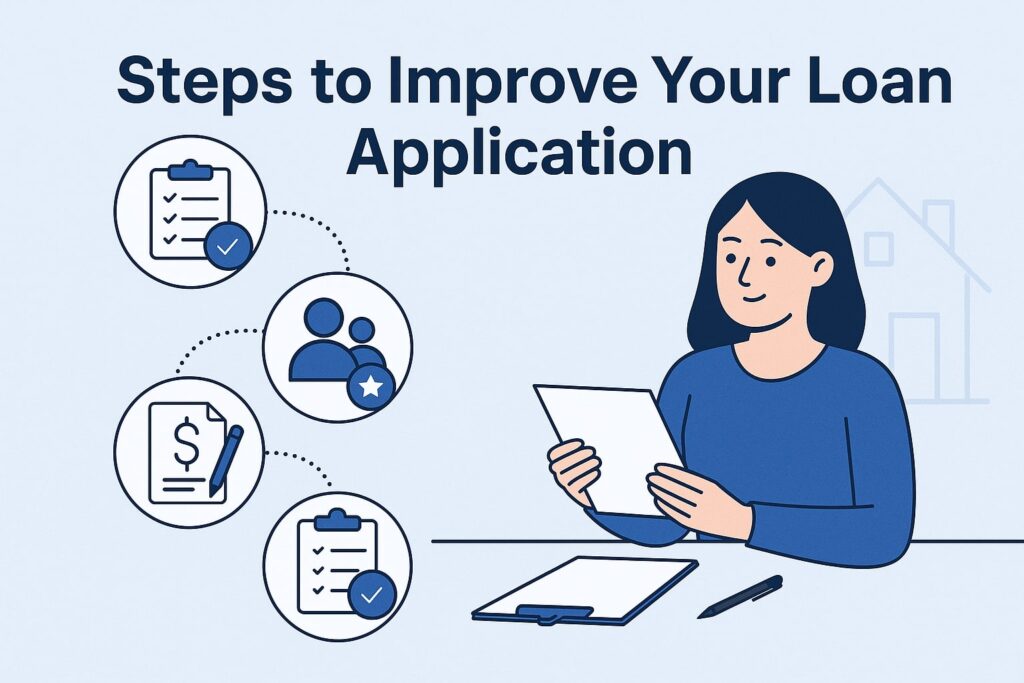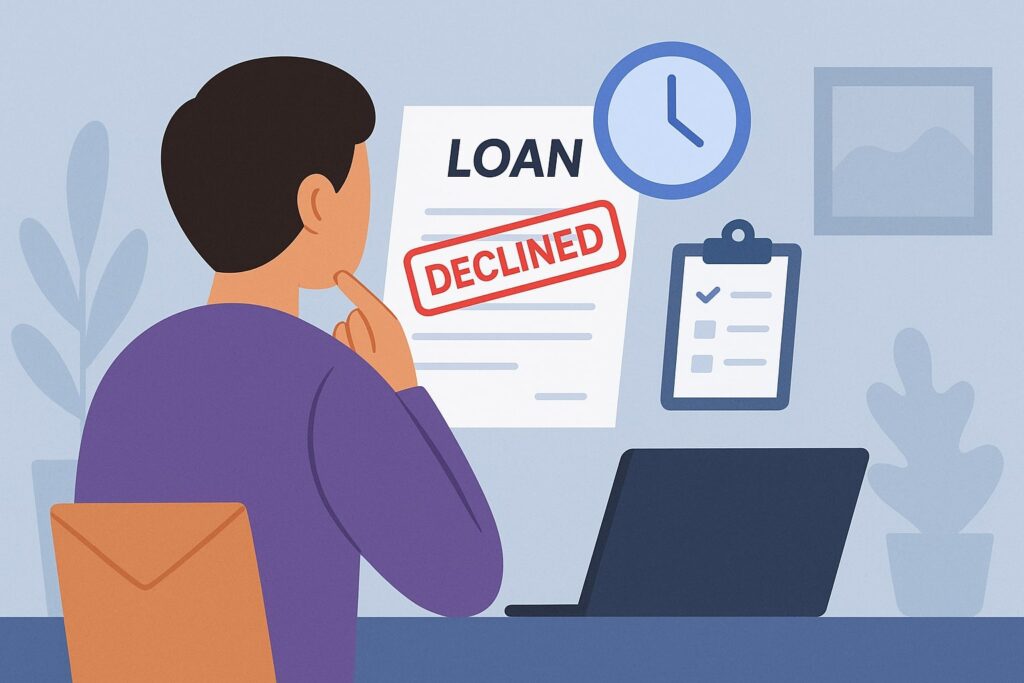
Loan Denied? Steps to Improve Approval Odds Next Time
If your small business loan application was recently denied or loan declined, don’t panic – you’re not alone. In 2024, roughly 22% of small business borrowers had their loan denied.
Lenders turn down loan requests for a variety of reasons (poor credit, insufficient collateral, etc. – discussed below), but a rejection isn’t the end of the road.
This guide explains why your business loan was denied and outlines steps to improve approval odds next time, including when to reapply (“loan declined – when can I apply again?”) and alternative financing options.
We’ll use up-to-date data and expert advice to help you turn that loan denial into a future approval.
Common Reasons Business Loan Denied

Lenders evaluate many factors before approving a business loan. Understanding these can help pinpoint why your application was refused. Common denial reasons include:
- Poor credit history or score. Lenders look at your personal and business credit profiles. A low FICO score or recent negative items (late payments, judgments, liens) is a red flag.
Many banks prefer personal credit scores around 670 or higher. If your score is weak, lenders may deny your loan. - High existing debt or debt ratios. Excessive debt obligations relative to income (high debt-to-income ratio) or low Debt Service Coverage Ratio can cause denial.
For example, a debt-to-income ratio much above ~36% or a DSCR below 1.25 often triggers a “no”. Too much debt means lenders worry you can’t afford new payments. - Insufficient cash flow or revenue. Lenders require proof that your business generates enough cash flow to repay the loan. If your revenues are low or volatile, the application may fail. As Bank of America notes, poor cash flow is a common red flag.
- Inadequate collateral or equity. Many loans (especially secured loans) require collateral. If you have few assets to pledge, or if the value is low, a lender may deny your request. Similarly, SBA loans require a personal equity injection (often ~10%) – failing to invest personal funds can lead to denial.
- Incomplete or incorrect application. Simple errors or omissions can sink an application. If you left out key financial statements or filled out forms incorrectly, the lender might reject it. Always double-check that your paperwork is complete.
- Short business history or high-risk industry. New businesses without a proven track record are riskier to lenders. If your business is very young or in an unstable industry (e.g. speculative ventures), some banks may decline.
As Bank of America points out, “not having a long track record in business” is a common reason for loan rejection. Likewise, certain industries (like gambling, religious nonprofits, political activities, etc.) are often ineligible for loans. - Unrealistic loan amount or purpose. Applying for far more money than your revenue supports, or with an unclear business plan, can raise suspicion. If the lender thinks you won’t use the funds wisely or can’t repay, they’ll say no.
Each lender also has its own criteria (minimum revenue, time in business, credit thresholds). If you simply didn’t meet the lender’s requirements, the loan will be denied.
Key takeaway: A business loan denial often stems from weak finances (credit, cash flow, high debt) or application issues. Identify which factor(s) applied to you and plan to address them.
What to Do Immediately After a Loan Denial

Even after a declined loan, you can take steps right away to improve your chances next time.
- Review the denial notice and seek clarity. The lender should send a letter explaining the reason. Read it carefully for clues (e.g. “insufficient cash flow” or “incomplete information”).
If the reason isn’t clear, call or meet with the lender to get more details. A Bankrate guide advises: “If you are denied a business loan, your first step should be to learn why”.
Bank of America similarly recommends sitting down with a small business specialist to “understand exactly what the issue was”. Use this insight to fix the underlying problem. - Check your credit reports. Each loan application triggers a hard inquiry on your credit. Multiple inquiries in a short time can lower your score. Review your credit reports for any errors or unexpected inquiries.
Dispute mistakes promptly and be aware of new inquiries, as these can affect future applications. - Avoid multiple applications right away. Applying to many lenders immediately after a rejection can flood your credit report with inquiries, which will temporarily ding your score.
OnDeck notes that while “hard credit pulls can impact your score, the effect … is temporary and usually minimal as long as you don’t apply too often in too short a time”.
In practice, wait at least a few weeks (or longer, see below) before submitting a new application. Use that time to address the issues identified. - Assess fixable issues first. If the denial was due to something within your control (e.g. low credit score or documentation errors), start improving those factors now.
For issues beyond your immediate control (e.g. time in business), consider alternative financing for the short term (see below).
Pro tip: Keep all communications professional. Understanding the exact reasons lets you target your next steps rather than guessing why you were turned down.
Steps to Improve Your Loan Application

Once you know why your loan was denied, take concrete actions to strengthen your business profile before reapplying:
- Boost your credit score. A better credit score immediately raises your approval odds. To do this, pay all bills on time, reduce outstanding balances, and set up automatic payments to avoid misses.
Check your reports for errors and dispute any you find; clearing a mistake can raise your score instantly. As Bankrate advises, “taking the time to build your credit can make it easier to qualify”.
If needed, consider short-term steps like adding a strong co-signer or credit-builder loan to raise your score. - Pay down existing debt. Lowering your debt burden improves your debt ratios and cash flow. Use any extra funds to reduce high-interest loans or credit lines. Even negotiating a lower interest rate or consolidating debts can help.
Bankrate suggests that if excessive debt was an issue, you should “pay off debt to lower your overall debt responsibilities, called your debt load”. Reducing debt not only helps on credit reports but also frees up monthly cash to demonstrate repayment ability. - Increase cash flow and revenue. Show the lender that your business can comfortably cover loan payments. Ramp up sales through marketing, optimize pricing, or cut non-essential expenses.
Invoicing faster and following up on receivables can improve liquidity. For example, if cash flow was cited as a problem, Bank of America recommends actions like “sending out invoices more quickly or delaying spending on optional purchases” to boost your numbers.
After making changes, prepare updated financial statements and projections to submit with your new application – concrete improvements on paper will reinforce your case. - Add collateral or equity injection. If lack of collateral was the issue, see if you can pledge additional assets (real estate, equipment, inventory) or use a personal guarantee.
For SBA and some bank loans, adding more of your own cash into the business (equity injection) can help. Nav explains that SBA loans generally require the owner to invest ~10% of costs upfront.
The more skin in the game you show, the more confidence lenders have that you will succeed. - Complete and strengthen your paperwork. A professional, thorough application goes a long way. Ensure you have up-to-date financial statements, tax returns, bank statements, and a clear business plan.
Detailing exactly how you will use the loan and how the business will grow reassures lenders. The Bank of America guide advises preparing a new application with your banker, clearly explaining “how you will use the funds and why you need the specific amount”.
Consider having your accountant or a Small Business Development Center (SBDC) advisor review your docs before re-submitting to avoid missing anything. - Align with the right loan product. Different lenders and products suit different businesses. If you were denied for a traditional term loan, maybe a line of credit or equipment loan is more realistic for your needs.
Review lender requirements (minimum revenue, time in business) before applying. If you weren’t eligible this time (too new or too small), look at alternative lenders who cater to startups or smaller companies.
OnDeck suggests reconsidering the principal amount: if you applied for too much, try requesting a smaller loan that your cash flow can easily service.
Here’s a quick reference table of common denial causes and corrective steps:
| Reason for Denial | How to Fix/Improve |
|---|---|
| Insufficient business history or high-risk industry | Build your revenue and credit profile over time, or seek lenders who finance newer businesses. |
| Poor cash flow | Increase sales and manage costs (e.g. faster invoicing, expense cuts) and present updated financials showing improvement. |
| Low credit score (personal or business) | Improve credit by paying bills on time, disputing errors on your reports, and reducing balances; consider small loans that report to credit to build score. |
| Excessive debt or high DTI | Pay down or consolidate debt to reduce monthly obligations and improve ratios. Lower debt makes you look more creditworthy. |
| Insufficient collateral | Pledge additional assets or apply for unsecured loans (like short-term loans, invoice financing) that don’t require heavy collateral. |
| Incomplete or inaccurate documentation | Ensure all required documents are complete and accurate. Work with a lender or advisor to review your application before reapplying. |
Tip: Each situation is unique. For instance, improving credit or paying debt can take time – use that waiting period (see next section) to make meaningful progress.
When to Reapply After a Declined Loan

Knowing how soon you can try again is important for planning. The timeline depends on the loan type and lender:
- SBA and certain government-backed loans: You must wait 90 days after a denial before reapplying for an SBA-backed loan. The Small Business Administration has a hard 90-day cooling-off period.
Use those three months to strengthen your application (boost credit, update financials, etc.) so you’re in better shape when you reapply. - Traditional bank or commercial loans: There’s no official mandatory wait, but experts suggest waiting at least 30 days before reapplying. This helps minimize the impact of credit inquiries and gives you time to fix issues.
Some advisors even recommend 3–6 months if possible. For example, a lending expert notes that after a denial, waiting “at least six months to apply again if you can wait that long” can be beneficial. The key is to allow enough time to make real improvements rather than rushing back. - Credit inquiries: Remember, every loan application typically involves a hard credit pull. As OnDeck explains, these pulls have only a temporary impact and usually are minimal if you don’t apply too frequently.
In other words, a single new application won’t devastate your score, but multiple submissions at once could.
Bottom line: You are generally allowed to reapply after a denial, but timing it right is critical. For SBA loans, plan on at least 90 days. For others, wait at least a month (or longer if you’re improving your profile). Use the wait to address the denial reasons. When you do reapply, clearly demonstrate how you’ve solved the issues.
Exploring Alternative Funding Options
If you need financing sooner or your prior application showed you need a different approach, consider these alternatives to a standard business loan. Each has pros and cons:
- Online business loans and alternative lenders. Many online lenders have simpler requirements than banks. They may lend to startups or lower-credit borrowers, and they fund quickly – sometimes in days.
The trade-off is usually higher interest rates and fees. These products often include short-term loans or revenue-based financing. For example, lenders might approve businesses with credit scores as low as 500, though interest will be steep. - Traditional bank loans. If your finances have improved, reapproaching a bank might work. Bank loans typically have the lowest interest rates and long terms, but they have strict credit, revenue, and time-in-business requirements.
If a traditional term loan isn’t an option, ask if the bank can offer a line of credit or a smaller loan amount. Sometimes banks will suggest an alternate product if you don’t yet qualify for a larger loan. - SBA loans. These are government-guaranteed loans (7(a) or 504) known for low rates and favorable terms. If you were denied an SBA loan, you could either reapply after 90 days or look into other SBA programs (like microloans).
Remember SBA 7(a) loans don’t require personal collateral beyond equity injection, but you must meet SBA eligibility (industry, revenue, etc.). - Business lines of credit or credit cards. Lines of credit and business credit cards can be easier to obtain than term loans and are ideal for ongoing working-capital needs or small purchases.
They won’t cover large one-time expenses, but they have relatively simpler approval criteria. A line of credit gives flexibility (you borrow as needed and pay interest only on what you use).
Business credit cards offer rewards but higher interest. If your loan was denied due to a large requested amount, a line of credit can be a useful compromise. - Invoice financing/factoring. If your business invoices other companies, you can use invoice financing or factoring. This means a lender advances you cash based on outstanding invoices (the invoices become collateral).
Approval is mostly based on the creditworthiness of your customers. It provides quick funds for businesses with receivables but often at a cost (fees or interest on the advanced amount). - Merchant Cash Advance (MCA). MCAs give you an upfront cash advance repaid via a percentage of future credit card sales. They have very fast approval and funding, but interest rates and fees are very high. Use an MCA only if you need money urgently and can handle high costs.
- Grants and crowdfunding. If your business qualifies (e.g. certain industries, non-profits, or innovative products), grants or crowdfunding platforms can raise funds without repayment obligations.
Grants from government or foundations are highly competitive and usually for specific goals. Crowdfunding (like Kickstarter or GoFundMe) works if you have a compelling pitch or product that attracts many small investors.
These options require time to prepare (grant writing or campaign marketing) but can bypass credit requirements.
Each alternative has trade-offs. If traditional loans remain out of reach, these options ensure you still access capital. Always compare costs and terms carefully.
Frequently Asked Questions
Q: Why was my business loan application denied?
Answer: Multiple factors could be at play. Commonly, poor credit, high existing debt, or insufficient cash flow cause denials. Lenders also look for adequate collateral, experienced ownership, and complete documentation.
Check the denial notice: it often cites issues (for example, Bankrate notes “borrower financials” and “bad credit history” as top reasons). Use the reasons given to pinpoint which areas to address.
Q: How can I improve my chances of loan approval next time?
Answer: Focus on the red flags from your prior application. Improve any weak areas: raise your credit score (by paying bills on time and lowering balances), reduce debt (pay off or consolidate loans), and increase cash flow (boost sales or cut costs as needed).
Also, ensure all financial documents are organized, and refine your business plan to clearly show how you’ll use the funds. Demonstrating stronger finances and a solid plan greatly increases your odds.
Q: When can I reapply after a loan denial?
Answer: You can reapply, but timing matters. For SBA loans, you must wait 90 days from the denial date. For other loans, there’s no fixed rule, but experts advise waiting at least 30 days before applying again.
Many lenders suggest waiting 3–6 months if possible so you can improve your credit and financials first. Importantly, don’t apply to multiple lenders at once – OnDeck reminds that hard credit pulls have only a small impact if infrequent, but too many applications in a short span can cumulatively hurt your score.
Q: Does applying to more lenders hurt my credit?
Answer: Each hard inquiry (credit check) from a loan application can lower your score slightly. However, the effect is usually temporary. OnDeck notes that “credit pulls do not affect your credit” score if they are soft inquiries, and even hard pulls “the effect … is temporary and usually minimal” as long as you don’t apply constantly.
In short, a single new application won’t wreck your credit, but multiple rapid applications should be avoided. Time your applications and focus on building your profile between attempts.
Q: What credit score do I need for a small business loan?
Answer: Requirements vary by lender. Generally, a personal credit score of 650–700 is considered good for bank loans.
Many banks prefer 670 or higher. If your score is below that, some alternative lenders may still approve (some online lenders accept scores down to ~500, but at higher rates). Improving your score will widen your options.
Q: Are there loans for new or low-revenue businesses?
Answer: Yes. If your business is very new or has limited revenue, look for lenders who specialize in startups or small firms. Online lenders often offer startup business loans with as little as 3–6 months in operation.
Additionally, small loans (like microloans up to $50,000) or credit cards might be easier to get. Even an SBA microloan or community lender could work. The key is matching your profile to the right product: for instance, invoice financing doesn’t require a long history, and a line of credit might be more accessible.
Q: Should I apply for a smaller loan amount?
Answer: Possibly. If you requested a loan size that far exceeded your business’s revenue or assets, that could have triggered the denial. Consider asking for a smaller amount that you can comfortably support.
OnDeck specifically advises that if “the amount you apply to borrow is too high, lenders may decide that payments are out of reach. If possible, consider reducing the loan principal you request and reapply”. Borrow only what you need and can justify.
Conclusion
A declined business loan isn’t the final word on financing your small business. By carefully diagnosing the reason for the denial and taking targeted steps to strengthen your financial profile, you can vastly improve your chances the next time.
Pay attention to credit scores, debt levels, and cash flow; gather complete documentation; and choose the right lender and loan product. Remember that for SBA loans you must wait 90 days to reapply, while for others it’s wise to allow time (often 30–90 days or more) to make fixes.
In the meantime, explore alternative funding sources (online lenders, lines of credit, etc.) so your business can keep moving forward even as you prepare a stronger application.
In summary: don’t give up after one “loan denied”. Use it as a learning opportunity. Improve the weak points (credit, collateral, business plan) and show lenders that you’re now in a better position. With persistence and preparation, you’ll be ready to reapply and secure the financing your business needs.